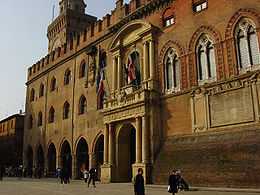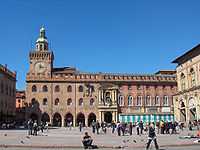Palazzo d'Accursio

Palazzo d'Accursio (or Palazzo Comunale) is a palace in Bologna, Italy. It is located on the Piazza Maggiore and had been the city's Town Hall until 11 November 2008.
Palazzo d'Accursio is home to the Civic Art Collection, with paintings from the Middle Ages to the 19th century. It also houses the Museo Morandi, with the works by Giorgio Morandi donated to the comune by his family.
History
Palazzo d'Accursio includes a complex of edifices which were united during centuries, but originally it was the residence of the jurist Accursius. In 1336 it became the seat of the Anziani ("Elder"), the highest magistrates of the commune, and then seat of the government. In the 15th century it was restored by Fioravante Fioravanti, who added, among the other feature, the Clock Tower (Torre d'Accursio). The bell was installed by Gaspare Nadi. Other restorations date to the 16th century, just after the fall of the seigniory of the Bentivoglio family in Bologna.
Art and architecture

The façade features a portcullis and a Madonna with Child, a terracotta by Niccolò dell'Arca (1478) in the upper section. Over the portal is a large bronze statue of the Bolognese Pope Gregory XIII (1580). A bronze statue of Pope Boniface VIII is now in Medieval Museum.
The Hall of the Communal Council, on the first floor, is where the Bolognese Senators met, and contains a frescoed gallery ceiling by Angelo Michele Colonna and Gioacchino Pizzoli (1675–1677). The quadratura ceiling depicts in four parts,:[1] 1) Minerva (goddess of knowledge) and Mars (god of war) convince Fame to trumpet the town's virtues. 2) Cybele (Magna Mater Goddess) pointing to the glory of Olympus, which could also be seen as a metaphor of Papal Power. 3) Bacchus, Pomona and Caeres are symbols of the fertile harvests of the surrounding farmland.
The Farnese Hall, on the second floor, was rebuilt in 1665 by Cardinal Girolamo Farnese: it was previously known as "Royal Hall", and here was crowned Charles V in 1530, as King of Italy with the Iron Crown (the imperial coronation instead took place in the Basilica of San Petronio). It has fresco decoration by pupils of Francesco Albani. The Chapel has frescoes by Prospero Fontana (1562). The Hall is decorated with stories of the city from the Middle Ages to the 17th century.
References
- Page on the palace (Italian)
Coordinates: 44°29′39″N 11°20′29″E / 44.49417°N 11.34139°E